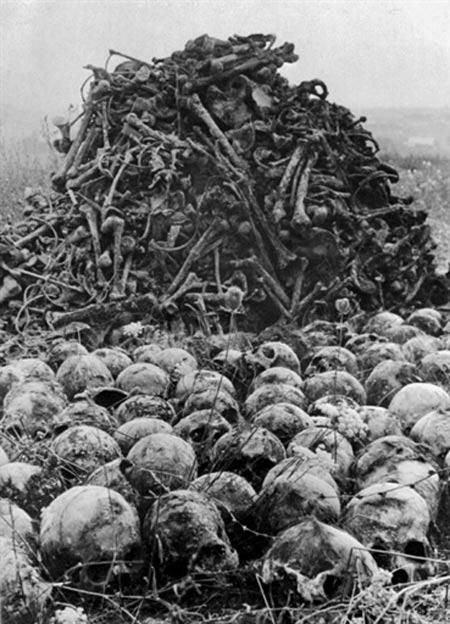THE GREEN REVOLUTION:
A NEW DEBT AGAINST THE FUTURE
THE WEST'S "SOLUTION" FOR THE DEVELOPING WORLD

Is the Green Revolution the solution for world hunger or a recipe for an even greater disaster?
The Green Revolution succeeded in saving an overwhelming number of lives around the globe from starvation. In the aftermath of World War II, there was a widespread panic about the growing human population in the developing world. It was feared that traditional farming methods would not be able to keep up with the hunger of this growing population. The Green Revolution was implemented and was responsible for preventing mass starvation around the globe.
New seed varieties were developed that could produce higher yields of crops than traditional methods. Vast amounts of chemicals were used to kill insects and competing forms of plants. Enormous amounts of water were used for irrigation.
As a result of the "Green Revolution" the world is now facing massive water shortages that only certain to get worse as time goes on. Meanwhile, pesticides and fertilizers are doing huge amounts of damage. Giant dead zones now sit offshore of the world's major rivers. We must remember that industrial fertilizers and pesticides were only invented in the last 100 years. There is no environmental track record to predict what these chemicals will do on a global scale.
A HOLOCAUST ON THE POPULATIONS OF BEES AND BATS
Many of the creatures necessary for replenishing our food systems are dying off in droves. Bee numbers are plummeting as billions of colonies die across the world. Five to six million bats have died since 2006 (Huffington Post). About one third of our food depends upon bees for pollination. Nationwide Beekeepers say that they've lost on average 40-50 percent of their hives (CBS News). Bats on the other hand act as a natural insecticide. One million bats can eat nearly 700 tons of insects per year. So what is the cause of this holocaust in the natural world?
Expansive pesticide use has been indirectly linked to the mass murder of both the bees and the bats. Some say that certain funguses and diseases are the direct cause of these deaths rather than pesticides. However, it has been shown that pesticides weaken the immune systems enough in bees and bats to make them susceptible to diseases they previously had a strong immunity against; this is similar to an HIV patient who will die of the common cold.
Neonicotinoids specifically have been responsible for killing off large numbers of bees. It is a chemical that was introduced to the global market place in the 1990's. Farmers no longer spray their crops with chemicals, they infuse the plants with neonicotinoids instead. While the chemical has been very successful in killing pests, it has also succeeded in killing off large numbers of bees.
The following study connects low doses of exposure to Neonicitinoids to a damaged immunity in Honey Bees: Interactions between Nosema microspores and a neonicotinoid weaken honeybees (Apis Mellifera)
OTHER COUNTRIES ACT, UNITED STATES LAGS BEHIND
The governments of Italy, Germany, France and elsewhere have already taken action against neonicotinoids to protect their pollinators and beekeepers are reporting recovery. Yet the regulators in the United States remain inactive, paralyzed by a system that finds chemicals innocent until proven guilty through massive damage.
The excessive use of these pesticides also creates a vicious cycle for farmers. The helpful creatures that eat pests are killed by the pesticides and as a result the pest population explodes.And thus more pesticides and harmful chemicals are needed.
POISONING THE NATION'S WATER
Pesticides are also running off into local water supplies. According to the U.S. Geological Survey ,"Pesticides in the Nation's Streams and Ground Water 1992-2001," toxic pesticides are finding their way into the nation's waterways and drinking-water supplies. Each year nearly a billion pounds of pesticides are used, which have possible links to cancer, birth defects, neurological disorders and environmental devastation. This study found that 96% of all fish, 100% of all surface water samples and 33% of major aquifers contain one or more pesticides at detectable levels.
Making America's Rivers Blue Again: Connecting the Dots Between Regenerative Agriculture and Healthy Waterways (Common Dreams, 2-17-21)
Two hundred years ago, before the Industrial Revolution, the rivers across North America ran clear and blue. Rivers from the mighty Mississippi to the Columbia flowed wild and clean into the sea.
Today’s agricultural practices result in rainstorms washing pesticides, fertilizers, feedlot manure, and bare soil into our waterways and oceans, turning rivers from clear reflections of blue skies to hues of greenish brown.
The good news: there are profitable and earth-friendly ways to grow nutrient-dense food, draw down carbon to address climate chaos, and return our rivers to their natural blue appearance. Check out the article to read more.
PESTICIDES ARE RELATED TO CHEMICAL WARFARE
Zyklon B, the gas used in the Nazi death camps, was a pesticide. Pesticides are generally from the same family of chemicals as military nerve gas agents.
The Nerve Gas, VX, has health effects similar to those produced by some pesticides. (New York Department of Health)
There are four pesticides currently in use on farms that derive from World War II Era Nerve Gas: methidathion, oxydemeton-methyl, methamidophos, and ethoprop.(The Daily Green)
RELEVANT PESTICIDE LINKS
Types of Pesticides (EPA)
Pesticides are killing our sperm (Grist).
Bees
Pesticides & Pollinator Decline (PAN North America)
Pesticide blamed for declining bee population (CBS News)
Sharp bee decline 'linked to pesticides' (Aljazeera)
Bee Decline and the Link with Pesticides (Pesticide Action Network UK)
Pesticide Lobby Spends Millions To Defend Chemicals Tied To Bee Deaths (Huffington Post)
Bats
Bat Disease, White-Nose Syndrome, May Increase U.S. Farm Pesticide Use: Study (Huffington Post)
FERTILIZER
Fertilizer use has replaced traditional methods of cultivating the soil around the globe. For example, some farmers may have used cow dung or other types of natural waste to replenish the soil. Yet now, in many places, excessive fertilizer use has deprived the soil of its natural nutrients. Chemicals are used to make up for the lack of minerals in the soil. This has left the soil gasping for breath. Soil pollution from heavy metals and fertilizer build up causes the soil to become more and more toxic over time.
Take the Punjab region of India for example. This is a region that has often been showcased as a "Green Revolution" success. Yet the results of a study conducted by Dr Reyes Tirado from the university of Exeter tell a different story. Dr. Reyes studied 50 villages in the Punjab region of India and found that chemical, radiation and biological toxicity were widespread in Punjab and that this high level of toxicity was connected to rampant fertilizer use and poisoning of the soil.
Threatening levels of chemical fertilisers in Punjab groundwater: Greenpeace study (Agrination)
Not only are fertilizers poisoning the soil, but they are also running off into local water supplies and creating dead zones on coast lines.
Farming Communities Facing Crisis Over Nitrate Pollution, Study Says (Food and Environment Reporting Network)
Is this the kind of success we can expect for the rest of the world as fertilizer use continues to expand?
One solution to help the soil would be to promote Low-Till Farming: a farming method in which disturbance of the soil is kept to a minimum. Major soil conservation methods need to be adopted.
IRRIGATION
The Green Revolution has demanded a vast expanse in the use of irrigation world wide. This has set in motion a giant reduction in the world's clean water supply. The ground water from aquifers is being over pumped by irrigation at a rate higher than what rain water can restore. For example, in the Punjab and Haryana regions of India, high yielding crops of rice require anywhere from 3,000 to 5,000 kilos of water to produce a single kilo of grain. Quantification of Yield Gaps in Rain-fed Rice, Wheat, Cotton and Mustard in India
The water tables in major agro-industrial regions are dropping precipitously every year. They are droppi ng faster than what we can restore.
Water balance of global aquifers revealed by groundwater footprint (Nature: International Weekly Journal of Science)
Also in many regions such as India, this process is leading to poisoning from Arsenic in the ground-water. Indian farmers traditionally relied upon shallow wells full of rainwater for their crops. But because of the irrigation needs of the Green Revolution, tube wells were dug to increase the amount of water that could be accessed. These tubes went down into the arsenic rich ground and then this ground water was used as the primary source of irrigation and drinking water.
This process is not only depleting water faster than the replacement rate, but it is poisoning drinking water as well.
Drip irrigation is a possible solution to this problem. It is a farming method that conserves water. Yet currently, it is only used in a small percentage of farms around the globe.
A GLOBAL FAMINE: THE RISK OF MONOCULTURE
In the middle of the 19th century, one million Irish died from the potato famine: the results of the British forcing the Irish people to survive from a single crop.
Today, we face a similar reality on a global scale. Much of the seed diversity around the world has been lost and replaced with mono-culture seeds (one type of crop). Mono-culture encourages further pesticide use and is more susceptible to diseases that agrochemicals cannot cure. Diseases that infect a specific plant are not a big concern on a farm with diverse crops. Yet if a farmer only grows one type of crop, it is much easier for a disease to spread and eventually kill the farmer's entire yield.
This monoculture has a high focus on the production of cereal grains. These grains are often used for export, feed for animals and conversion into biofuel. Because of the Green Revolution, fewer people die of starvation and hunger, yet many are affected by malnutrition in the developing world.
Monoculture and the Irish Potato Famine: cases of missing genetic variation (Berkeley)
Green Revolution and Hunger (UN Post)
Biodiversity & intercropping alternatives to GE biotech monoculture (Portland Independent Media Center)
Monsanto and Gates Foundation Push Genetically Engineered Crops on Africa (Truth-Out)
The Downside of Expecting America's Agriculture System to Feed the World (Alternet)
FINDING ALTERNATIVES TO A POISONOUS FOOD SYSTEM
In fairness, the Green Revolution did save millions of people in the developing world from starvation. Yet it has been a short term boon with long term environmental debts. Chemicals are increasingly becoming the structure of world agriculture. Every day the populations of creatures necessary to our food systems (such as the bees) are dying off in droves. With only 50% of the original bee population left, we don't have the luxury of endless debates and chemical company funded studies before we change our course. Are we going to wait until there is a massive disaster on a global scale before we take action? The Green Revolution is a system built on tenuous roots. It creates a greater and greater likelihood for a famine or disease to wipe out the entire structure of our modern food systems.
The good news though is that there may be alternatives. The chemical dependent Green Revolution is not the only way to feed the world. Around the world, there is growing support for the return to traditional, natural methods of food cultivation. Such methods can be done without the use of GMO's and chemicals. Such methods can also take advantage of local agriculture rather than handpicking a few nations to be the bread basket for the world.
We are not totally opposed to all GMOs but we would like to see more organic solutions.
We are what we eat. Would we rather be toxic or organic? An effort to restore a sane food system is necessary for survival and global health. If we can muster the will power, we can change the poisonous structure of world agriculture.
Biodiversity Based Productivity: A Framework for an Alternative Economic Assessment for Sustainable Agriculture (Google Books: Vandana Shiva)
Miracle grow: Indian farmers smash crop yield records without GMOs (Grist)
Russia's Small Scale Organic Model (True Activist)

